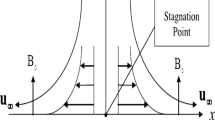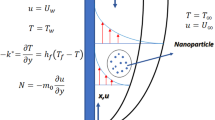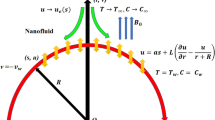Abstract
In the present paper, we study the magnetohydrodynamic stagnation point flow dealing with heat and mass transfer of a micropolar nanofluid influenced with heat generation and viscous dissipation. Nonlinear ordinary differential equations are obtained by applying suitable similarity transformation on the governing partial differential equations. These differential equations have been solved by successive linearization method (SLM). The effects of various dimensionless parameters, such as heat generation parameter, thermophoretic parameter and stagnation parameter on the flow field, are discussed through tables and graphs by accumulating sufficient data using SLM. Results show many important facts, including temperature distribution gradual increment with the increase of heat generation and microrotation parameters. Quadratic multiple regression analysis has been performed for skin friction coefficient, local Sherwood number and local Nusselt number. When free stream velocity and stretching velocity are equal, variation in microrotation and magnetic field leads to very low perturbation in skin friction, local Sherwood number and local Nusselt number, whereas when free stream velocity is dominant over stretching velocity, there occurs reverse heat flow at the surface of the sheet.
















Similar content being viewed by others
Abbreviations
- a, b :
-
Arbitrary constants
- \({B_0}\) :
-
Magnetic field
- C :
-
Fluid concentration
- \({Cf_x}\) :
-
Skin friction coefficient
- \({C_\mathrm{{w}}}\) :
-
Species concentration at the surface
- \({C_\infty }\) :
-
Ambient species concentration
- \({c_p}\) :
-
Specific heat at a constant pressure
- \({D_{\mathrm{{B}}}}\) :
-
Coefficient of Brownian diffusion
- \({D_\mathrm{{T}}}\) :
-
Coefficient of thermophoretic diffusion
- \(\mathrm{{Ec}}\) :
-
Eckert number
- f :
-
Stream function
- \(j_\mathrm{{f}}\) :
-
Microinertia density
- K :
-
Material parameter
- k :
-
Vortex viscosity
- \({k_\mathrm{{f}}}\) :
-
Thermal conductivity
- Le:
-
Schmidt number
- M :
-
Magnetic parameter
- N :
-
Microrotation or angular velocity
- Nb :
-
Brownian motion parameter
- Nt :
-
Thermophoretic parameter
- Nux :
-
Local Nusselt number
- Pr:
-
Prandtl number
- Q :
-
Heat generation coefficient
- \({q_\mathrm{{w}}}\) :
-
Heat transfer rate
- Rex :
-
Local Reynolds number
- Shx :
-
Local Sherwood number
- s :
-
Stagnation parameter
- T :
-
Fluid temperature
- \({T_\mathrm{{w}}}\) :
-
Fluid temperature at stretching sheet
- \({T_\infty }\) :
-
Ambient fluid temperature
- u :
-
Fluid velocity component in the x direction
- \({u_\mathrm{{w}}}\) :
-
Stretching velocity
- \({u_\infty }\) :
-
Free stream fluid velocity
- v :
-
Fluid velocity component in the y direction
- x, y :
-
Coordinate directions
- \(\alpha \) :
-
Heat generation parameter
- \({\gamma _\mathrm{{f}}}\) :
-
Spin gradient viscosity
- \(\theta (\eta )\) :
-
Dimensionless temperature
- \({\mu _\mathrm{{f}}}\) :
-
Dynamic viscosity
- \({\upsilon _\mathrm{{f}}}\) :
-
Kinematic viscosity
- \({(\rho {c_p})_\mathrm{{f}}}\) :
-
Heat capacity of base fluid
- \({(\rho {c_p})_\mathrm{{p}}}\) :
-
Nanoparticle heat capacity
- \({\rho _\mathrm{{f}}}\) :
-
Fluid density
- \(\sigma \) :
-
Electric conductivity
- \({\tau _\mathrm{{w}}}\) :
-
Surface shear stress
- \(\phi (\eta )\) :
-
Dimensionless concentration
References
Choi SUS (1995) Enhancing thermal conductivity of fluids with nanoparticles. ASME-Publications-Fed 231:99–106
Xie H, Wang J, Xi T, Liu Y, Ai F, Wu Q (2002) Thermal conductivity enhancement of suspensions containing nanosized alumina particles. J Appl Phys 91:4568–4572
Abu-Nada E (2008) Application of nanofluids for heat transfer enhancement of separated flows encountered in a backward facing step. Int J Heat Fluid Flow 29:242–249
Wen D, Ding Y (2004) Experimental investigation into convective heat transfer of nanofluids at the entrance region under laminar flow conditions. Int J Heat Mass Transf 47:5181–5188
Abu-Nada E, Oztop HF (2009) Effects of inclination angle on natural convection in enclosures filled with cu-water nanofluid. Int J Heat Fluid Flow 30:669–678
Eringen AC (1966) Theory of micropolar fluids. J Math Mech 16:1–18
Ariman T, Turk M, Sylvester N (1974) Applications of microcontinuum fluid mechanics. Int J Eng Sci 12:273–293
Crane LJ (1970) Flow past a stretching plate. Z Angew Math Phys 21:645–647
Ramzan M, Farooq M, Hayat T, Chung JD (2016) Radiative and joule heating effects in the mhd flow of a micropolar fluid with partial slip and convective boundary condition. J Mol Liq 221:394–400
Pal D, Mandal G (2017) Thermal radiation and mhd effects on boundary layer flow of micropolar nanofluid past a stretching sheet with non-uniform heat source/sink. Int J Mech Sci 126:308–318
Hayat T, Khan MI, Waqas M, Alsaedi A (2017a) Radiative flow of micropolar nanofluid accounting thermophoresis and brownian moment. Int J Hydrog Energy 42:16821–16833
Hsiao KL (2017) Micropolar nanofluid flow with mhd and viscous dissipation effects towards a stretching sheet with multimedia feature. Int J Heat Mass Transf 112:983–990
Nadeem S, Hussain M, Naz M (2010) Mhd stagnation flow of a micropolar fluid through a porous medium. Meccanica 45:869–880
Das K (2012) Slip effects on mhd mixed convection stagnation point flow of a micropolar fluid towards a shrinking vertical sheet. Comput Math Appl 63:255–267
Ibrahim W, Shankar B, Nandeppanavar MM (2013) MHD stagnation point flow and heat transfer due to nanofluid towards a stretching sheet. Int J Heat Mass Transf 56:1–9
Mahmood A, Chen B, Ghaffari A (2016) Hydromagnetic hiemenz flow of micropolar fluid over a nonlinearly stretching/shrinking sheet: Dual solutions by using chebyshev spectral newton iterative scheme. J Magn Magn Mater 416:329–334
Salem AM, El-Aziz MA (2008) Effect of hall currents and chemical reaction on hydromagnetic flow of a stretching vertical surface with internal heat generation/absorption. Appl Math Model 32:1236–1254
Gorla M, Chand K, Singh A (2015) Effects of rotation and heat source on mhd free convective flow on vertically upwards heated plate with gravity modulation in slip flow region. Proc Natl Acad Sci, India, Sect A Phys Sci 85:427–437
Lukaszewicz G (1999) Micropolar fluids: theory and applications. Springer, Berlin
Beg A, Bhargava R, Rashidi MM (2011) Numerical simulation in micropolar fluid dynamics: mathematical modelling of nonlinear flows of micropolar fluids. Lambert Academic Publishing
Batchelor GK (1988) An introduction to fluid dynamics. Cambridge University Press, Cambridge
Yuan SW (1967) Foundations of fluid mechanics. Prentice Hall, Englewood Cliffs
Mahapatra TR, Gupta AS (2002) Heat transfer in stagnation-point flow towards a stretching sheet. Heat Mass Transf 38:517–521
Layek GC, Mukhopadhyay S, Samad MA (2007) Heat and mass transfer analysis for boundary layer stagnation-point flow towards a heated porous stretching sheet with heat absorption/generation and suction/blowing. Int Commun Heat Mass Transf 34:347–356
Makukula Z, Sibanda P, Motsa S (2010) A note on the solution of the von kármán equations using series and chebyshev spectral methods. Bound Value Probl 2010:471793
Motsa SS, Sibanda P (2012) A linearisation method for non-linear singular boundary value problems. Comput Math Appl 63:1197–1203
Eldabe NT, Ouaf ME (2006) Chebyshev finite difference method for heat and mass transfer in a hydromagnetic flow of a micropolar fluid past a stretching surface with ohmic heating and viscous dissipation. Appl Math Comput 177:561–571
Kumbhakar B, Rao PS (2015) Dissipative boundary layer flow over a nonlinearly stretching sheet in the presence of magnetic field and thermal radiation. Proc Natl Acad Sci, India, Sect A Phys Sci 85:117–125
Sarkar S, Seth GS (2016) Unsteady hydromagnetic natural convection flow past a vertical plate with time-dependent free stream through a porous medium in the presence of hall current, rotation, and heat absorption. J Aerosp Eng 30:04016081
Seth GS, Jana RN, Maiti MK (1981) Unsteady hydromagnetic flow past a porous plate in a rotating medium with time-dependent free stream. Rev Roumaine Sci Tech Ser Mec Appl 26:383–400
Author information
Authors and Affiliations
Corresponding author
Additional information
Publisher's Note
Springer Nature remains neutral with regard to jurisdictional claims in published maps and institutional affiliations.
Significance Statement
Investigation of MHD stagnation point flow of micropolar heat generating and dissipating nanofluid is significant due to its application in the manufacturing of plastic substance, polymer extrusion, lubricant, etc. Effect of the magnetic field, microrotation, heat generation, Brownian and thermophoretic diffusions along with viscous dissipation and Joule heating on the fluid flow is analysed. Governing equations are solved by successive linearization method (SLM). The numerical results are validated in the limiting sense with published research article. Magnetic field, thermophoretic and Brownian diffusions, viscous dissipation, heat generation and microrotation have a significant effect on the rate of heat and mass transfer.
Rights and permissions
About this article
Cite this article
Seth, G.S., Kumar, B., Nandkeolyar, R. et al. Numerical Simulation of MHD Stagnation Point Flow of Micropolar Heat Generating and Dissipative Nanofluid : SLM Approach. Proc. Natl. Acad. Sci., India, Sect. A Phys. Sci. 91, 503–515 (2021). https://doi.org/10.1007/s40010-020-00704-x
Received:
Revised:
Accepted:
Published:
Issue Date:
DOI: https://doi.org/10.1007/s40010-020-00704-x




